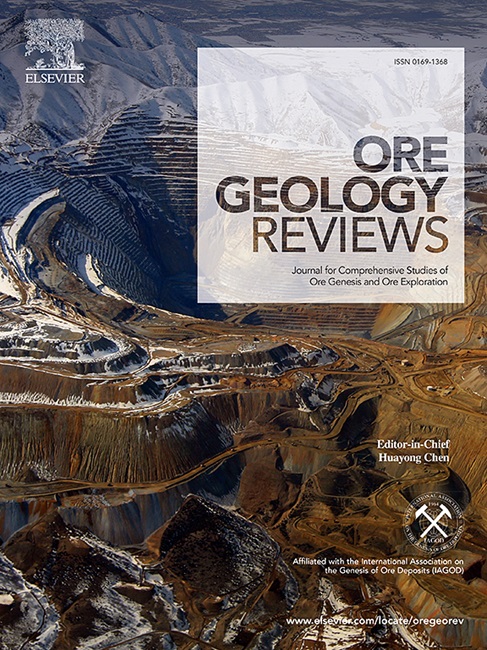Newly recognized Late Jurassic Nb-Ta pegmatite dikes in the Maoershan-Yuechengling pegmatite district, south China: Their petrogenesis and metallogenesis
IF 3.2
2区 地球科学
Q1 GEOLOGY
引用次数: 0
Abstract
The Maoershan-Yuechengling pegmatite district (MYPD) of south China contains more than 2000 pegmatite dikes, most of which show rare-metal mineralization, for example, Nb, Ta, Be, and Rb mineralization. However, petrogenesis of the pegmatite dikes and their rare metal metallogenesis remain unclear due to lack of reliable geochronological and geochemical constraints. In this paper, we report new data of whole-rock geochemistry, Nd-Pb isotopes, and columbite–tantalite (coltan) and zircon U-Pb ages of the pegmatite dikes and their hosting gneissic granite from the Mao’antang deposit, the largest Nb-Ta deposit known in the district. The Mao’antang pegmatite dikes occur in the Moshishui area in a linear distribution pattern due to fault structural control. The area are dominated by Caledonian granitoids and Neoproterozoic metasedimentary rocks. Two coltan U-Pb ages of the mineralized pegmatites (159.5 ± 5.4 Ma and 155.0 ± 2.7 Ma) obtained in this study distinct them from the well documented, episodic Precambrian to Mesozoic rare-metal pegmatites in south China, for example, the 832–827 Ma, 424–387 Ma, 248–198 Ma, 140–127 Ma, and 70–40 Ma mineralized pegmatites. The Mao’antang Nb-Ta pegmatites are much younger than their hosting granite which is dated at 417.2 ± 2.0 Ma in this study. The large age gap (262–258 million years) indicates no direct petrogenetic association between the pegmatites and their hosting granite. Geochemically, the pegmatites have high Rb/Sr (6.63–215.2) ratios but low Nb/Ta (0.07–0.98) and Zr/Hf (4.02–35.63) ratios, indicating that the pegmatites are highly evolved. The Nd (εNd(t) = -9.8 to −4.6; TDM2 = 1.35–1.79 Ga) and Pb (206Pb/204Pb = 18.267–20.497; 207Pb/204Pb = 15.628–15.834) isotopic data suggest that the parental magmas of the pegmatites were originated from a mixed source of Proterozoic crustal material with minor mantle-derived melts. Based on euhedral coltan grains, low ratios of Nb/Ta, and Zr/Hf, and the new geochronological data, it is proposed that the Mao’antang mineralized pegmatites were evolved by fractional crystallization from residual parental magmas. Late Jurassic Nb-Ta rare-metal pegmatites are notably uncommon in south China. Recognition of their occurrence not only confirms the episodic nature of the south China rare-metal mineralized pegmatites, but also guides future exploration strategy for rare metals in south China.

求助全文
约1分钟内获得全文
求助全文
来源期刊

Ore Geology Reviews
地学-地质学
CiteScore
6.50
自引率
27.30%
发文量
546
审稿时长
22.9 weeks
期刊介绍:
Ore Geology Reviews aims to familiarize all earth scientists with recent advances in a number of interconnected disciplines related to the study of, and search for, ore deposits. The reviews range from brief to longer contributions, but the journal preferentially publishes manuscripts that fill the niche between the commonly shorter journal articles and the comprehensive book coverages, and thus has a special appeal to many authors and readers.
 求助内容:
求助内容: 应助结果提醒方式:
应助结果提醒方式:


